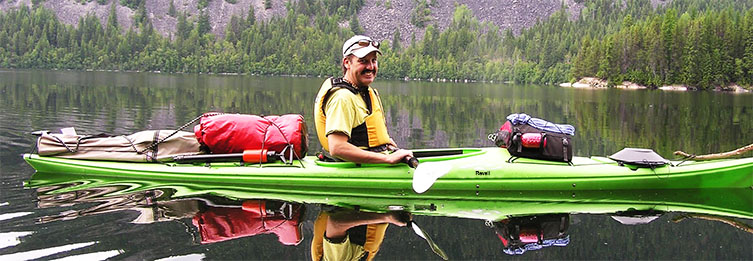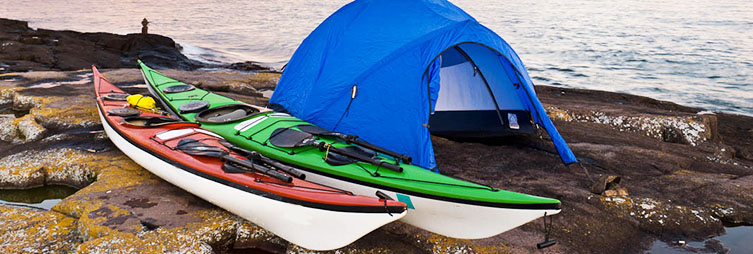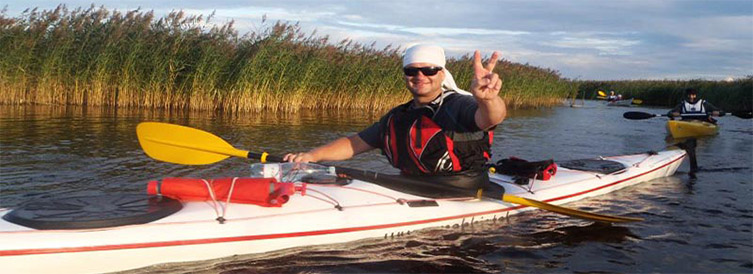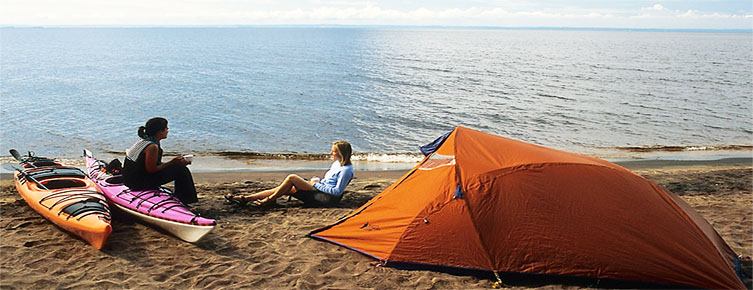Many nature objects, including Estonia’s proud limestone coast, cannot be seen from anywhere else than moving towards it slowly from the sea, kayaker Simmo Kikkas thinks.

First of all, let’s make it clear that a kayak is not a canoe and paddling is not rowing. The kayak is a closed top sea proof water vehicle that originates from the Eskimos, a canoe has an open top and is meant to be used in inland waters. Paddling uses one paddle and the paddler is always facing the direction they’re going, rowing always uses two paddles at the same time and their backs are to the direction they’re going. That’s it for the direction. A paddler won’t be too offended if someone calls them a rower (thanks to Jüri Jaanson’s Olympic medal, rowing is simply more popular as a sport) – when getting into the boat, he still gets one paddle that has a blade at both ends, because it’s better to use in waves or white water.
We’re not talking about rowing as a sport, but as a way of moving, which is as natural of a way of getting forward for people on water as walking is on land. Paddling races are a very small part of the whole paddling culture. A large part of the world’s paddling enthusiasts use a kayak as a way to spend time on a half-hour stimulating exercise all the way up to an expedition lasting weeks. The phenomena of this exciting activity is based on two facts: the kayak really is a sea proof vehicle that can tolerate a moderate storm without sinking and a lot of necessary equipment used for getting by in uncivilised places from a tent to photo equipment can be put in its waterproof holds.
The most common one-person sea kayak models fit around 110-150 L of equipment in the holds, kayaks meant for two people generally fit 90-120 L per person.

Versatility is a trump
The charms of kayaking appear mostly in the versatile opportunities of using this cleverly built vehicle. In the case of a tour lasting a whole week, the main goal is usually not to go a certain amount of kilometres, but enjoy the outdoors, discover new places, be with friends and experience many different situations. The opposite of a longer tour is kayak surfing, where a kayak without any equipment in it is used to play with large waves. In that case people go to a windy beach with the goal of testing their physique and skills in span of a few hours, riding against the waves from the beach, to then glide back towards the beach with the wave. Unlike from surfers on surf boards that are dependant on the wind, the kayak surfer’s best friends are big waves. The best time to surf is when the wind is already going down, but the waves reaching the beach are still big and foamy enough to embrace the paddler with the kayak and take them back to the shore again. In normal weather conditions, the kayak can be put to shore in any beach that has at least 15 cm of water under the bottom. Therefore the kayak doesn’t need special conditions for going into the water or getting out of it. The only limitation is the distance of the nearest road from the beach, because generally kayaks are taken near the beach either on top of a car or on a trailer. A fully equipped kayak is not hard to carry by a few people for a couple of a hundred metres; to transport it on dry land for longer distances, a little handcart has to be used.

Sinks, doesn’t sink…?
The person sitting in a kayak is very close to the water’s surface when paddling, and when pulling through the water, their hands often get wet. This closeness to water affects people’s evaluation of the safety of this water vehicle. According to the usual logic of an urbanised person, being as high from the water surface as possible should also proportionally increase safety. However, this opinion is wrong. First of all, even big waves pass under the kayak easily without disturbing its trajectory. Like with a bird swimming in the sea, only large bow waves are dangerous for a kayak. Secondly, a person sitting in the kayak has the physical and mental readiness for changing conditions that is completely different from a passenger on a cruise ship. The only factor that makes moving on water in a kayak more dangerous than some vehicles on earth is the risk coming from general health disorders and falling into the water, which can be fatal to a person. Therefore, kayaking alone is considered the biggest risk, because it’s quite easy for the other person in the kayak to prevent the risks posed by health disorders and careless mistakes. There is nothing else scary or unknown for the paddler to be scared of – the boats and paddles are made strong and easy to maintain, and water can’t get into the boat’s holds, which makes the kayak unsinkable. Therefore, with the right attitude and knowledge, it’s possible to prevent all risks on water. Driving on the Tallinn-Tartu highway, preventing risks is even harder than when paddling on water.

The sea and mountains – opposite and alike
It might be a strange comparison, but being far out on the sea, looking at the empty line of sight creates a similar feeling of universe as being up on the mountains thousands of metres from the sea. A dialogue with nature’s forces is simultaneously calming and alerting. A standing or lightly cradling body of water can become a foamy hell and a stage for waves higher than buildings with the help of wind. However, these are extreme conditions of water and nobody knowingly plans long tours on a stormy sea. You have to always be ready for changing conditions on the sea, as you do with mountain hiking. Hiding from the storm on an abandoned islet isn’t a common situation, but a merry sea kayaker accepts it like a mountain hiker accepts two days and nights in a tiny tent in the base camp.

Paddling calendar on the Baltic Sea / kayak tours in Estonia
The Baltic Sea is a shallow inland sea and there are no ocean waves here; but for kayaking, our own home sea offers great conditions. When it comes to water temperature, the coastal sea is good for paddling with no special clothing for four months. There is usually more than one closing angle on islands and islets, which allows you to replan your tours taking into account the wind direction. The official weather forecast is good to know, but changing conditions and westerly winds that are common on our coast have to be taken into account.
Longer tours are usually out of the question for an amateur from October until April, because the wind speed on the autumn sea can go up to 10 m/s almost every day and when facing the paddler it means at least double use of strength when going at a normal tour tempo (6-7 km/h). A falsely planned crossing can mean being out of strength in the middle of the sea.
In the spring months, melting ice masses and lumps floating around on the sea have to be taken into account. Although this period isn’t long in the case of most winters on the Estonian coast. The shallow Straight Sea between islands is the first warm “oasis” in the spring, where you can paddle all day without getting cold, while the Gulf of Finland is still icy. April-May is the usual good time to start looking for your paddling cognition and training muscles on shorter rides on inland waters. The best months for a fresh amateur to plan their first long tour are July and first half of August. Air as well as water are most likely warm in Estonian waters at this time and solving new situations during the tour shouldn’t be too difficult.

About the equipment
Estonians are lucky – good hiking kayaks are produced in our own country and the price is about the same as an average bicycle. A beginner hobbyist can get all the necessary equipment (in addition to the boat you need a paddle, splash skirt and life jacket) in one day, what takes time is learning to use all that. This basic set is enough for shorter sea crossings or going by the coast, when planning for longer tours you have to increase the budget for equipment as well. First of all you need to follow up on safety equipment. To get a full experience from kayaking, even a hobbyist’s arsenal becomes more complete over time with different convenience equipment that includes comfortable clothes, a choice of waterproof bags to pack different things, etc.

Take care of the environment!
The unwritten rules of kayakers say that a kayaker moves around in the nature without leaving any tracks and disturbing the wildlife. When visiting islands and islets, take into account any possible wildlife protection laws and private land.


